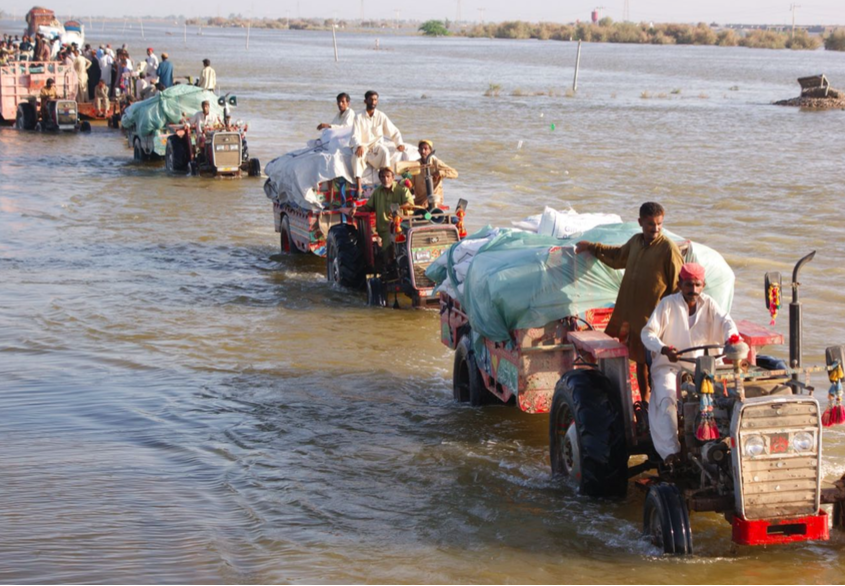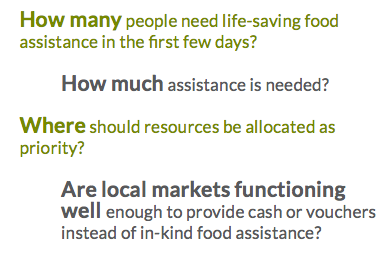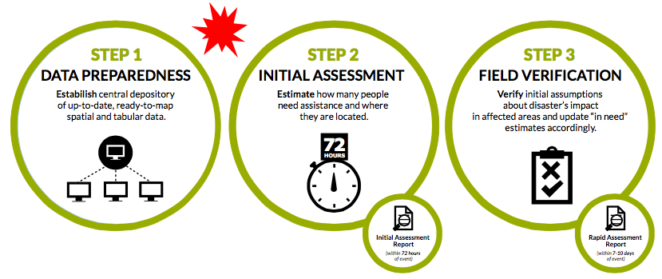Disaster response: The 72-hour Emergency Assessment approach

Introduction
One of the biggest problems faced by the World Food Programme (WFP) after a disaster is lack of information on its impacts: how many people need assistance, and where. Current emergency assessments – which are often released weeks (sometimes months) after a disaster – simply do not provide information quickly enough to guide critical operational decisions in the first few hours and days.
The “72-hour assessment approach” aims to quickly get information to WFP and government decision-makers when they really need it – not weeks later. It provides a “good enough” snapshot to fill the initial information vacuum, followed by continuous updates over the following weeks as more information from the ground comes in.
This article* provides an overview of the aims and components of the 72-hour assessment method. It also shows the 72-hour approach in action in a Nepal earthquake case study (see further resources for a case study in Sri Lanka). It will be useful to other organisations working in humanitarian aid, disaster response and institutional strengthening for disaster preparedness. WFP will continue to test out the 72-hour approach throughout Asia and beyond to further refine and adapt it to different country contexts and different types of sudden onset disasters. It is critical that the method keeps evolving over time, to keep up with fast-changing information needs and sources.
*The full report is available for download in the right-hand column. An overview of the approach is provided below.
Why the 72-hour assessment approach? (abridged)
One of the most direct humanitarian impacts of climate change will be more frequent and intense sudden-onset climate disasters such as floods and cyclones – exposing both governments and communities to increasing losses and damages. For governments and humanitarian agencies such as WFP, this means that climate adaptation is not just about helping people address climate risks at the community level. Adaptation must also occur at the institutional level – by equipping humanitarian organizations and national departments of disaster management to respond faster and more frequently to disasters.

One of the biggest problems faced by governments and humanitarian organizations immediately after a natural disaster is the lack of information on the disaster’s impact: which areas were hit hardest and how many people need food assistance. Most government and humanitarian agencies have well-established procedures for carrying out emergency assessments to answer these questions. In practice, however, these assessments often do not provide information quickly enough to guide the tough decisions that need to be made in the first 72 hours.
The main aims of the 72-hour Emergency Assessment approach are:
- Providing decision-makers with information when they need it – not weeks later.
- To improve – in a systematic way – how WFP targets its assistance after disasters, in order to deliver food or cash faster, and to the right people.
- Although its main testing ground has so far been Asia-Pacific countries, the aim is to expand its use globally.
Components of the 72-hour approach (abridged)
Step 1: Data preparedness
The first phase aims to ensure that the necessary information needed to generate those first impact maps and figures (areas most affected, number of people needing food assistance etc.) are easily accessible as soon as a disaster hits. This is key to being able to produce an initial assessment in the first few hours of a disaster, as it means that precious time is not wasted in collecting, cleaning and preparing the data, and the analysis can be carried out immediately.
Step 2: The initial 72-hour emergency assessment
Given the need to prioritize immediate assistance to those most in need, the method is designed to classify and rank affected areas based on impact, and provide an estimate of the numbers of people needing assistance in each of these areas. This is done by overlaying three layers of information, all of them obtained remotely without on-the-ground data collection:
- Estimated geographic impact of the disaster. Each area is classified by level of impact – from low to high – based on the available preliminary reports from national disaster agencies, media, satellite imagery, national and international weather monitoring agencies, etc.
- Number of people in each area. Population numbers are derived from georeferenced census information, which should ideally already be stored in the SDI before the disaster (see section above, Step 1: data preparedness).
- Assumed “resilience” of the population to the given disaster. The level of “resilience” in each area is classified from low to high, based on indicators such as poverty or housing quality (also geo-referenced and stored in the SDI).
These three layers are then combined to provide a summary map of the priority areas for humanitarian assistance (classified from priority 1 to 3), and the number of people in need of assistance in each of these areas. This map is complemented with key contextual information on the affected areas: population profile (livelihoods, diet, food consumption levels), existing social protection systems and logistics, infrastructure and market characteristics.
Step 3: Updating and adjusting the initial analysis in the following days and weeks, based on data from the field
This step involves regularly updating the initial analysis, during the weeks following the disaster. The 72-hour assessment released in the first few hours is clearly not an end in itself – it is merely the initial step of what should be a fluid, continuous assessment (or rather, re-assessment) process.
The idea is to regularly re-run the analytical model used in the initial 72-hour secondary analysis, using updated, field-based data on affected areas and numbers of affected people (including any population movements). This is used to produce revised priority areas and numbers of people needing assistance. This will provide essential information to guide programme decisions over the first month following the disaster (or until a more in-depth household field assessment is conducted, if needed).

Suggested citation
WFP (2017) The 72 hour Emergency Assessment approach. World Food Programme: Rome, Italy.
(0) Comments
There is no content